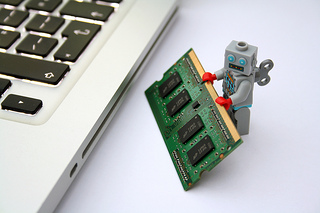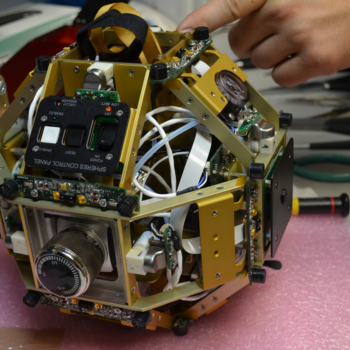Sabine Hauert is a Lecturer in Robotics at the University of Bristol and a researcher at the Bristol Robotics Laboratory. Hallie Siegel is an editor and science communications expert. Together with a group of dedicated volunteers, they run Robohub, a website that shares news, ideas, and research on robotics with the public and an online community of academics, entrepreneurs, and educators.
Dr. Hauert and Ms. Siegel spoke with Footnote about their work to make research more accessible to the public and encourage communication between academia and industry. They also clued us in on microbots that may revolutionize surgery and a competition that helps launch promising robotic technologies.
This may seem like an obvious question, but why robotics? What’s interesting about the field right now?
Hallie Siegel:
Many experts believe that we are nearing a tipping point where robots will emerge from industrial settings and soon enter our homes, workplaces, and public spaces. With that will come questions such as if and when robots will steal our jobs, surpass us in intelligence, or pose a threat to our privacy and security. One reason Robohub has grown so quickly is that we have tapped into questions like these that have caught the public’s imagination.
Sabine Hauert:
[As an academic, what make robotics interesting is that it’s] a melting pot of academic disciplines that mixes mechanical engineering, computer science, mathematics, materials science, bioengineering, medicine, neuroscience, psychology, ethics, and law.
Where does Robohub fit into these conversations? What is the site’s mission?
Sabine Hauert:
As a researcher in robotics, you quickly realize that there is a gap between what your robots are doing in the laboratory and how the public perceives them. My Ph.D. research on swarms of flying robots for communication in disaster areas sometimes gave rise to articles that made it look like we were ready to save the world.(a) I wondered how we could report on our findings in a truthful manner, like we do in the academic world, while making the content accessible to the public…
We launched Robohub as a way to bring all the best robotics content together under one roof and make it easy for the public to learn about real robots and the people who make them. We also wanted to build a forum where people from different parts of the robotics community – researchers, entrepreneurs, investors, hobbyists – could connect with each other, discuss and debate issues, and stay on top of developments outside their central area of expertise…
We’ve learned that roboticists and innovators have amazing stories that the public wants to know about. By enabling roboticists to share their stories in their own words and by making research transparent and accessible, I hope we can close the gap between researchers and the public, inspire future roboticists, spur innovation, and drive discussion.
What are some of the coolest, most groundbreaking stories you’ve covered?
Hallie Siegel:
One of the most exciting research stories we covered in the past year was micro robots being used for minimally-invasive eye surgery.(b) This work is currently moving into clinical trials, and we offered an insider’s look at the challenges the researchers faced as they brought their research to the clinical stage.
Another important research story we covered recently was an algorithm designed to help autonomous quadrocopters recover after a propeller loss. This story came out right around the time that both Amazon and UPS announced that they were planning to launch drone delivery services, and people were justifiably wondering about the safety of unmanned aerial vehicles in a commercial context.
Around the same time, Google announced its acquisition of several robotics companies, including Boston Dynamics, Schaft, Nest, and DeepMind. All this caused quite a stir in the robotics community and the mainstream press. In response we launched a focus series called Big deals: What it means to have the giants investing in robotics, where we invited well-known robotics experts to lend their insight. We interviewed Gill Pratt, Program Director at DARPA, to find out what he thinks of about Google buying up some of the technologies that DARPA has spent years building.(c)
 This raises an interesting question: When it comes to robotics, what is the relationship between the academic/research community and industry?
This raises an interesting question: When it comes to robotics, what is the relationship between the academic/research community and industry?
Sabine Hauert:
Historically, the robots on the market were mostly industrial robots on assembly lines. Robots are now permeating new areas, from healthcare to personal services to entertainment, with the aim to increase our productivity and improve our quality of life. Roboticists are launching startups and the big players, such as Google, Amazon and Apple, are taking interest.(d) Venture capitalists are jumping on the band wagon, with several dedicated [investment] funds created in the past few years. These dynamics have strongly increased the amount of interaction between academia and industry and reshaped the private and public funding landscape…
Still, academic research is where it all starts! Universities are the only environments where you can explore pie-in-the-sky ideas and dream of a faraway future. The challenge is translating research from the lab into concepts that are applicable in the real world.
What role does Robohub play in connecting academia and industry?
Hallie Siegel:
Obviously, having a platform where academics, policymakers, business professionals, investors, and entrepreneurs are all reading about each other’s work and ideas helps to facilitate communication between these groups. For example, last year we ran a series of interviews with leading robotics researchers who had successful technology transfer stories to learn about what obstacles they faced along the way.(e)
We are also helping to tackle the problem of technology transfer in other ways. Earlier this year we started Robot Launch 2014, the first global robotics start-up competition, in collaboration with Silicon Valley Robotics. The competition attracted 75 companies from 19 countries, from both the business and academic communities. The grand winner was Leka, a developer of intuitive and intelligent toys for children with autism. Their product, Moti, is a robotic ball that is sensitive to its environment, moves on its own, and changes colors to emote feelings, helping autistic children learn to regulate their own emotions.
What are the challenges and rewards of working with academics? What lessons have you learned about how to translate research for a broader audience?
Sabine Hauert:
Our platform is different from other robotics websites because rather than sending out journalists to cover a story, most of our articles come directly from the roboticists themselves. This way our readers know that they are getting unfiltered content from the experts…
But of course busy researchers and entrepreneurs sometimes need help to talk about their work in way that the public can understand… Some researchers have given up on communicating their work to the public because they worry it will be misinterpreted or hyped. It’s really satisfying when we can work with academics to help them explain their work in a way that is accessible to the public without diluting their original message… In essence we are not just helping the public to learn about robotics, but we are helping roboticists to learn about effective communication…
Interestingly, I always thought science communication was just a service to the community. Turns out, researchers get a lot out of it as well! It’s very satisfying for them when their article gets picked up by mainstream media and goes viral. [I’ve also found it is] a powerful tool to advance my academic research. Science communication has helped me find collaborators, Ph.D. students, and speaking opportunities.
Sidenotes
- (a) Swarm robotics aims to build clusters of robots that can self-organize and act collectively. Approaches are often based on studying swarm behaviors in biological organisms such as flocks of birds and colonies of ants.
- (b) These microscopic robots are powered and controlled by external magnets, enabling them to squeeze into tiny spaces with minimal damage.
- (c) DARPA, the Defense Advanced Research Projects Agency, is a U.S. government agency that develops new military technologies. In addition to funding many robotics research projects, DARPA hosts an annual robotics challenge in which teams compete to develop robots that can complete certain tasks.
- (d) Accelerator programs like Robot Launch Pad – launched by Andra Keay, a core member of the Robohub community – are also supporting the growth of robotics startups.
- (e) Technology transfer is the movement of technology or innovation from one area to another. The term is often used to refer to the process of turning a promising development from a university research lab into an actual product sold by a business.





